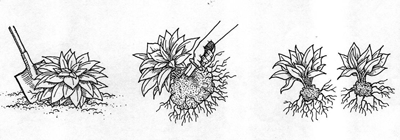The Right Place
Most hostas thrive in partial shade or even shade, although they appreciate some bright light for part of the day. Many of the yellow foliaged ones are brighter if they get some sun. A few with variegated foliage will take full sun and hot summers. Under really shady conditions hostas may produce no flowers and fewer leaves, but the leaves will be larger. Hostas prefer moist soil that has some organic matter in it. That means mulching around the plants in their early stages is important.
Planting Nursery Stock
Plant potted hostas from the nursery or garden center any time after the soil has warmed and dried out a bit from spring rains. They can go in the ground almost any time during the planting season. Keep their soil moist until you are ready to plant. Loosen the soil at the planting site down 8 or 10 inches with a trowel or shovel, breaking up large clumps and removing stones and debris. Then smooth it for a planting bed. This is a good time to work in some organic material such as chopped leaves, compost, or peat moss to improve the soil texture and its ability to hold moisture. Space plants about the same distance apart as their expected mature height to allow room for their foliage when it unfurls completely. If you make a mistake and plant them too closely, they are easy to transplant later.
Dig a hole in the prepared soil for each hosta plant. Make it roughly the width and depth of the container it is in. Remove the plant from its pot and set it in the hole so that its crown, where the roots join the stems of the plant, is level with the surface of the surrounding soil. Fill in the hole around the rootball with the soil you have just dug from the hole and press it gently around the crown of the plant. Then water it very well. Surround the new transplants with some kind of organic mulch to cover the soil.
Hostas can be grown and displayed in large pots and planters, though they may be a bit smaller than normal. Even the larger types can manage fine in 3 gallon containers for years. Be sure to locate the containers in partial shade and keep them watered well in the summer. In the North protect hostas in containers from extreme winter cold by sinking the pots in the soil before the ground freezes, setting them in a cold frame, mounding mulch around the outsides of the pots, or wrapping the sides and bottom of their containers with an insulating material such as burlap or bubble wrap.
 |
Propagating
After several years hosta clumps become pretty large and may begin to outgrow their space. The best way to reduce their size is to divide them. This can be done almost any time during the season. However, spring, when their new shoots emerge from the soil and before they grow into large leaves is the best time. To divide a hosta, dig up the entire clump with a sturdy shovel and lift it onto the ground with its roots exposed. With a sharp spade, knife or ax, cut down through the mass of soil-encrusted roots several times, to create rooted chunks, or divisions, of the original plant. Replant a smaller chunk in the original hosta spot and either plant the others elsewhere or give them away. These new, small divisions will reach full size in 3 to 5 years.

